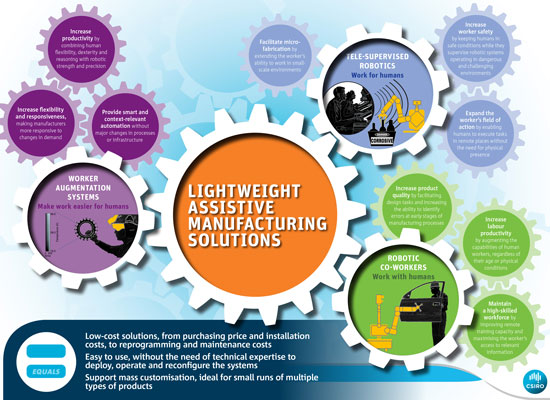| May 07, 2013 |
A new breed of factory robots focused on safety and sustainable manufacturing
|
|
(Nanowerk News) A new breed of industrial robots and ICT systems could transform Australia’s manufacturing sector, creating safer environments and more efficient factories, according to a CSIRO whitepaper.
|
|
To be launched at National Manufacturing Week (8 May), the whitepaper ("An initiative to enhance SME productivity through fit for purpose Information and Robotic technologies: The value of Lightweight Assistive Manufacturing Solutions") highlights the issues facing Australia's manufacturing sector and presents a new category of technologies built to encourage human-robot work practices.
|
 |
| A breakdown of the different technologies which make up Lightweight Assistive Manufacturing Solutions.. (click image to enlarge)
|
|
The paper outlines how current tools available to manufacturers are built for high volume mass-manufacturing, but that new economic drivers require manufacturers to focus more on low-volume, highly customised and high value-add products.
|
|
Known as Lightweight Assistive Manufacturing Solutions, these new systems are designed to enhance the workers skills, actions and tasks, not to replace them. They include virtual reality headsets, smart robots which can be taught to multi-task and tele-supervised robots which can be controlled over the internet.
|
|
A drive towards more ICT enabled advanced manufacturing was one of the key opportunities identified by the Prime Minister’s Manufacturing Taskforce in 2012 in its report Smarter Manufacturing for a Smarter Australia.
|
|
"Australian Manufacturing is shifting away from large-volume production to mass customisation, and companies are telling us they need more flexible systems to deliver these more customised products. This whitepaper seeks to highlight these trends and present solutions which will enable Australian industry to address these challenges," says co-author and CSIRO business development manager Dr Peter Kambouris.
|
|
"Industrial automation used in manufacturing today is limited, but developments in ICT and robotics present Australia with an opportunity to change the way we manufacture. CSIRO believes lightweight robotics and advanced ICT systems are one way of meeting this challenge," he adds.
|
|
A virtual headset called ReMote is one system being trialled by industry. Using a head-mounted camera the wearer (worker) is able to beam what they can see to anyone (expert/helper) in a remote location. The helper is then able to project their hand gestures onto whatever the worker is looking at and virtually show them how to fix an issue or conduct a repair.
|
|
Systems like ReMote have been designed with safety in mind and allow workers to operate in hazardous environments and safely execute complex tasks.
|
|
"Our focus has been on creating systems which can help people and businesses work safer and smarter. Our consultation with industry has shown that safety, flexibility and affordability are the three drivers for Australian industry," says Dr Kambouris.
|
|
The whitepaper, titled "An initiative to enhance SME productivity through fit for purpose Information and Robotic technologies" will be launched on Wednesday 8 May at National Manufacturing Week in Melbourne. It has been drafted based on in-depth interviews with SMEs from Queensland and Victoria.
|

